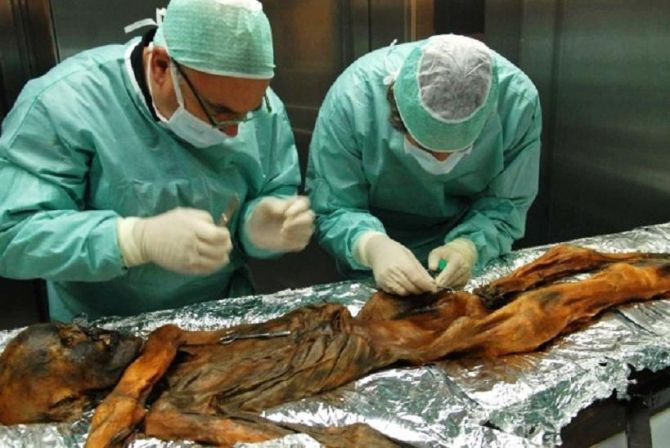Murdered Neolithic "Iceman" Had Brown Eyes, Type O Blood & Mediterranean Relatives

Scientists have published the full DNA sequence of “the world’s most famous frozen corpse” of Ötzi the “Iceman,” who experts believe was killed nearly 5,300 years ago, on Tuesday.
Ötzi had been discovered by Hikers in the Alps near the Italian–Austrian border 21 years ago in 1991, and has become one of the most studied cadavers in science as well as possibly the world’s oldest documented murder case.
Analysis on the full genome of the mummified “Iceman” revealed that he had brown eyes, type-O blood, was lactose intolerant, was predisposed to heart disease, and was infected with borrelia borgdorferi, a bacterium that causes Lyme disease and joint pain.
Although Ötzi had been very active, and was not obese, lead author of the sequencing study Albert Zink and his team discovered that the ancient man had a “genetic predisposition” for arteriosclerosis or hardened arteries, accounting for calcium deposits researchers had found in the past from cadaver scans.
"The evidence that such a genetic predisposition already existed in Ötzi's lifetime is of huge interest to us. It indicates that cardiovascular disease is by no means an illness chiefly associated with modern lifestyles. We are now eager to use these data to help us explore further how these diseases developed," said Zink in a statement released Tuesday.
Previously researchers had also discovered that the ancient “Iceman” had tooth cavities, tattoos and had eaten wild mountain goat before he died with an arrow stuck in his back.
Scientists had speculated four years ago, after fully sequencing DNA taken from Ötzi’s cellular mitochondria, that the “Iceman” had belonged to a people that has vanished from Europe, after they the 2008 sequencing contained mutations not found in present-day populations.
“We would like to know as much as possible about his living conditions, about himself and also his cause of death. We really tried to reconstruct a crime scene as much as possible,” Zink said to Nature.
In the latest genome sequencing study, Sink sequenced the DNA from the nuclei of cells that had been taken from a splinter of the Ötzi’s pelvic bone, which accounted for about 96% of the iceman’s complete genome.
Zink and his team had also found that Ötzi possessed a Y chromosome with mutations that are most commonly found in Sardinian and Corsican men, and that his nuclear genome indicated that his closest modern relatives were from the those two Mediterranean islands.
The scientists now predict that Ötzi’s kind had once migrated from the Middle East as agriculture and cattle-breeding became more prevalent and spread across Europe before dying out or mating with other groups in other places, except on those islands.
Other experts agreed with the hypothesis.
“Sardinians are a group that people have considered distinct from other Europeans, and in this regard it would be interesting if they were more widely distributed in the past,” Eske Willerslev, a palaeogenomicist at the University of Copenhagen told Nature.
Published by Medicaldaily.com



























